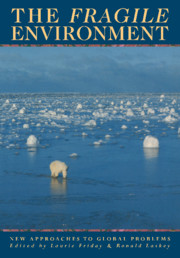8 - Observing earth's environment from space
Published online by Cambridge University Press: 03 May 2010
Summary
Stories told by distant travellers have long provoked the imaginations of placebound listeners. One such account telling about the adventures of a young former Cambridge student during his five-year circumnavigation of the earth was published in 1839. In The Voyage of the Beagle, Charles Darwin gives us his first narrative exploration of experiences and reflections that eventually created a lasting revolution in the sciences.
Today we live in an age when travellers can circle the earth in approximately 90 minutes. Their stories and photographs, when coupled with the data returned by unmanned satellite sensor systems, can be the guide to new discoveries about our environment. In this chapter I propose to take the reader on an orbital photographic journey around the earth and to demonstrate that many of the issues discussed by the other contributors to this series can be examined through evidence seen by unaided vision from the altitude of the Space Shuttle orbiters, averaging about 280 km. Since in no way can one attempt to do justice to all NASA programmes of terrestrial observation and the many investigations currently pursued by other agencies and university research groups, I shall choose to focus on several topics of personal interest. These include the fate of tropical forests, the nature of the African drought environment, the factors changing global climate, the geological hazards posed by particular volcanoes and the dynamics and biology of the world's oceans.
Exploring the earth from orbit
Before beginning to consider environmental topics, it is useful to recall the historical development of earth surveillance from space.
- Type
- Chapter
- Information
- The Fragile EnvironmentThe Darwin College Lectures, pp. 148 - 192Publisher: Cambridge University PressPrint publication year: 1989
- 2
- Cited by

